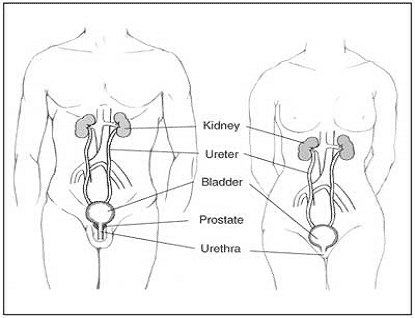|
| | We know: All About Over Active Bladder or Incontinence
What is over active bladder or incontinence?
Loss of bladder control, or incontinence, is not a disease but a symptom of a broad range of conditions and disorders. These include birth defects, pelvic surgery, injuries to the pelvic region or to the spinal cord, neurological diseases, multiple sclerosis, poliomyelitis, infection, an enlarged prostate, and degenerative changes associated with aging. It can also occur as a result of pregnancy or childbirth, weak bladder muscles and overactive bladder muscles.
Who is likely to have incontinence?
It can happen to anyone, but is very common in older people. At least 1 in 10 people age 65 or older has this problem. Symptoms can range from mild leaking to uncontrollable wetting. Women are more likely than men to have incontinence.
What are the kinds of incontinence?
There are several different types of urinary incontinence:
- Stress incontinence happens when urine leaks during exercise, coughing, sneezing, laughing, lifting heavy objects, or other body movements that put pressure on the bladder. It is the most common type of bladder control problem in younger and middle-age women. In some cases it is related to childbirth. It may also begin around the time of menopause.
- Urge incontinence happens when people can't hold their urine long enough to get to the toilet in time. Healthy people can have urge incontinence, but it is often found in people who have diabetes, stroke, Alzheimer's disease, Parkinson's disease, or multiple sclerosis. It is also sometimes an early sign of bladder cancer.
- Overflow incontinence happens when small amounts of urine leak from a bladder that is always full. A man can have trouble emptying his bladder if an enlarged prostate is blocking the urethra. Diabetes and spinal cord injury can also cause this type of incontinence.
- Functional incontinence happens in many older people who have normal bladder control. They just have a hard time getting to the toilet in time because of arthritis or other disorders that make moving quickly difficult.
What are some of the treatments for incontinence?
- Pelvic muscle exercises (also known as Kegel exercises) work the muscles that you use to stop urinating.
- Sometimes doctors suggest a small, throwaway patch; a small, tampon-like urethral plug; or a vaginal insert called a pessary for women with stress incontinence.
- A doctor can prescribe medicines to treat incontinence. Some drugs prevent unwanted bladder contractions. Some relax muscles, helping the bladder to empty more fully during urination. Others tighten muscles in the bladder and urethra to cut down leakage. These drugs can sometimes cause side effects such as dry mouth, eye problems, or urine buildup. Vaginal estrogen may be helpful in women after menopause. Talk with your doctor about the benefits and side effects of using any of these medicines for a long time. Injections may have to be repeated after a time because your body slowly gets rid of these substances.
- A doctor can inject an implant into the area around the urethra. The implant adds bulk. This helps close the urethra to reduce stress incontinence.
- Sometimes surgery can improve or cure incontinence if it is caused by a problem such as a change in the position of the bladder or blockage due to an enlarged prostate. Common surgery for stress incontinence involves pulling the bladder up and securing it. When stress incontinence is serious, the surgeon may use a wide sling. This holds up the bladder and narrows the urethra to prevent leakage.
- You can now buy special absorbent underclothing. It is not bulky and can be worn easily under everyday clothing.

|
